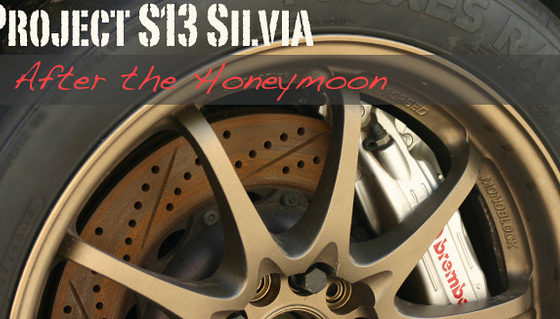
Project Silvia got its iconic flat-black paint job out of necessity. Before we shook the can, Project Silvia was a sad sight. The right rear fender was rendered in grey primer (which helped conceal the lumpy Bondo), the left front fender was white, and still had Japanese junkyard scribble on it, and the rest of the car was the classic, original toothpaste green and dark grey two-tone that only Nissan could have dreamt up.
We had to do something, but Primedia's laughable pay scale meant we couldn't afford to fix the Bondo and spray the car, even if we let Earl Scheib do it. Instead, we took inspiration from a Rockabilly Cadillac parked down the street and spent $50 on a case of flat-black spray paint.
Achieving a passable paint job with a spray can is not nearly as simple as you might imagine. Here are some tips:
Flat only.
First, a flat or satin finish is key. Gloss paint is very picky about how thick it goes on. it needs to be thick enough to flow together into a smooth surface, which is usually about the same thickness it starts dripping. Flat paint is much more forgiving.
Prep is everything.
We prepped each panel by sanding with a Ryobi random orbital sander and 180-grit sandpaper. We then washed off the dust with water, let it dry, and wiped it down with acetone just before spraying.
Spray past the car.
You should spray in quick, overlapping passes, always keeping the can perpendicular to the car, and always maintaining a steady speed so the paint goes on at an even thickness. To accomplish this, each pass needs to start and end past the end of the car. If you change direction while spraying, you'll leave a thick spot where you turned around. Likewise, when you push the trigger, the first bit of paint comes out in big drops that leave distinctly sloppy looking splotches.
Work in small sections.
An even finish without the blotches and stripes of most can jobs requires painting fast enough that the paint from the last pass of the can is still wet when the next, overlapping pass gets laid down. Achieving this takes several tricks. First, paint in small sections with natural borders, and mask off adjacent sections to avoid overspray. Paint just the left front fender, for example. Or just the lower half of the rear fender. Always separate your individual paint jobs at natural body seams, though, or your masking marks will be obvious. This becomes extremely difficult on large panels like the hood or, worst of all, the roof. Also, avoid painting when it's hot, as the paint will dry too quickly, or when it's humid, since the paint won't want to stick to a moist surface.
Keep up the pressure.
Getting a good, fine spray requires high pressure in the can. As it runs low on paint, it also runs low on pressure. We soaked the half-spent cans in boiling water. The heat both thins the paint, so it makes finer droplets as it sprays, and increases the pressure in the can.
Stay upright.
Cans spray best when they're upright. Remove the hood and trunk and paint them up against a wall so you don't have to tilt the can. When it comes to the roof, you're screwed. Just make sure you use a new can up there, as full cans are more forgiving.
Lower your expectations.
And now for the sad, honest truth. Project Silvia never looked as good as you thought it did. Josh Jacquot shot almost every picture of the car, and it turns out he knows how to make a crappy car look good. If you follow all these instructions to the letter, and then only look at the car when its freshly washed, the sun is setting, and you're 100 feet away, it will look perfect.
 |
| Follow all this advice to the word, and your car will still look like this after sitting in the sun for 2 years. |
What went wrong.
Almost as soon as the car was painted things started going wrong. Bird shit, for example, eats right through spray paint, leaving behind rust spots if you ignore it. Edges and corners that weren't prepped well enough immediately started shedding paint. Each time we washed the car, a few more spots of original green paint showed up.
Black cars are also significantly hotter than toothpaste green cars, it turns out. During the first summer of blackness, slimy, waxy goo started oozing out of the door jams and the lock cylinder on the trunk lid. The lock lube and the tacky schmoo Nissan used to hold the vapor barrier plastic behind the inner door panels couldn't take the heat. Naturally, once it runs down the flat black paint, it soaks in, making a shiny spot that can't be fixed. The only solution is to sand, repaint, and wait for it to ooze again.
 |  |
The years have not been kind to the Krylon. Feeble prep work on the plastic grille means it's one of the few places paint actually peeled, but that's small consolation.
 |
Fading reveals my technique of painting in small sections to achieve an even finish. Masking along the body line let me paint just the top of the door in one pass, a small enough section to make even application easy. Before the fading, this technique was invisible. This fading would be a great lesson in the value of Krylon over Rustoleum. Or is it Rustoleum over Krylon? If I had taken notes, we'd all know more… |
 |
| The only part of the body where painting small panels and masking along body lines is impossible is the continuous sheet metal that makes up the roof and both rear fenders. There is simply no way to mask these panels discreetly, so you'll have to blend. Again, when it was fresh, this blend wasn't noticable. |
Flat black paint jobs are easy to touch up, and the delicate finish gave us many reasons to do so. I took this opportunity to experiment with different brands, spraying some sections with Krylon and others with Rustoleum. Turns out there's a huge difference, as the years have turned some sections of the car grey, while others retained their blackness. It also turns out that if you want to make long-term comparisons like this you really need to take some notes. I have no idea which one faded…
| Go back to the main story-> |  |



